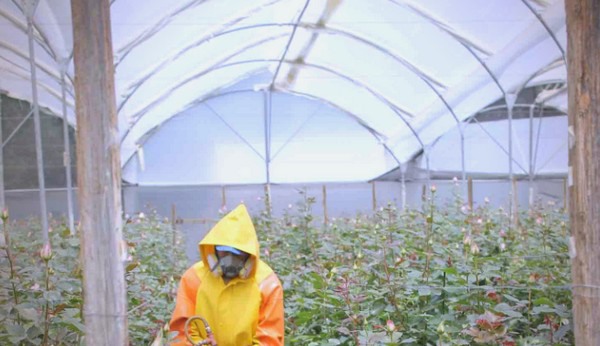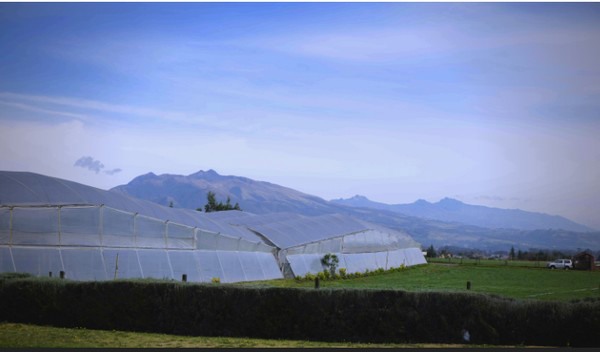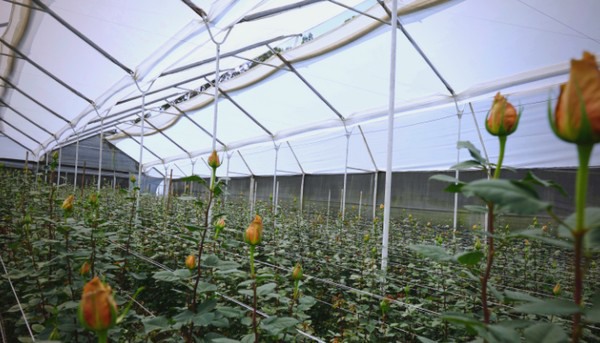Nature has given us beautiful flowers in different shapes, sizes, and colors, but without a doubt the ones that stand out the most for the multitude of color variations are roses. Virgin farms have interviewed two of their most important suppliers from the farms Ecoroses and Flowerfest in Ecuador. Wilfrido Cazar from Ecoroses, and Santiago Santillán from Flowerfest, shared their knowledge on the interesting process of maintaining the striking colors of roses.
By the team of Virgin Farms
In previous visits, we have seen the entire production process, but this time we wanted to get up close to the technology that exists to retain the extraordinary colors of roses throughout the production stage. We discovered that there are three fundamental factors to obtain a flower with perfect petals and flashy colors.

The first is the climatic conditions of the area. Roses grow in temperate climates in regions with moderate temperatures and are located at least 2,400 meters above sea level. Farms are usually in zones with low humidity, very little wind, or cloud cover, and where there is plenty of sunlight.
The second contributing factor is the type of plastic used in greenhouses. Its function is to filter the sunlight properly within the nursery. Too much sun can burn the petals, and some colors such as red roses are more sensitive to sunlight.

Lastly, the control of temperature and humidity within the greenhouse is key to color preservation. As we walked through large hectares of plantations with Wilfredo Cazár of Ecoroses, we conversed about the three types of greenhouse plastics that exist, which are arranged according to the color of the rose. The process begins by selecting the variety of the rose to be planted. Once this is determined the corresponding greenhouse plastic is placed, which, according to its specific characteristics, will allow sufficient light through to nourish the rose.
The three types of plastic material for the nurseries have varying concentrations to allow the sun’s rays to filter ultraviolet.
For solid-colored roses, such as white and red, plastic with a 100% UV filter is used. This type of greenhouse plastic aims to prevent the flower from tanning because if this happens the petals begin to burn; a term in the floriculture industry referred to as blackening.
For bi-color roses in shades, such as yellows and oranges, another type of plastic allowing 50% of ultraviolet light is used. These colors do not need as much UV protection as the white and the red varieties. The objective of allowing a specific percentage of ultraviolet light allows the color of the rose to intensify.

For color-edged roses, which are those that have a different color on the edge of the petal-like Paloma or Deep Purple, a plastic with zero filters is placed for the greenhouse, allowing sunlight to pass through completely. As a result, the colors of the roses are accentuated, especially the upper part of the petals. The red-edged roses become more blazing and the yellow-edged roses more vivid.
Greenhouse plastic is normally changed for red and white roses after a period of two years and plastics for the other types of shades after a period of three years. This is because the filter starts losing its effect due to the UV rays.
Temperature stability
For rose cultivation, depending on the area, high-tech greenhouses are often used with heating systems, as well as humidity and temperature control.
The climate in Ecuador throughout the year is temperate; however, in the months of June to September it is hotter and in the months from January to April it is the rainy season. Therefore, the temperature inside the greenhouses must always be monitored, so that it is not affected by heat or rain.
Inside the covers, there is a constant balance of temperature and humidity. In case the temperature rises, the side curtains of the greenhouse are opened so that the air circulates to prevent diseases from developing and affecting the roses.
In the rainy season, greenhouses are kept at a higher temperature so as not to affect the coloring of the rose. With more rain, the humidity increases, and this can cause fungus on the flower. Therefore, when the temperature is increased, the humidity decreases the cycle of the fungus and eliminates it, preventing the flower from being damaged.
Similarly, if the ambient temperature drops or there is frost, heaters are placed in the greenhouses to keep the flowers in optimal terms. When the temperature drops significantly, the rose goes into dormancy and stops producing blooms. Temperature stability guarantees the quality of production.
Altitude above sea level guarantees more intense coloration
The climatic conditions in Ecuador are extremely favorable because the plants are at 3,200 meters above sea level and the climate is constant. The temperature throughout the year fluctuates between 64°F to 71°F. Roses may be grown at 2,400 meters high, but higher altitude increases the robustness of roses resulting in bigger, thicker stems and intense colors.
Ecuadorian roses are world-famous because of these climatic conditions. They stand out for their dazzling colors, their button size, and the length of the stem. The roses produced at higher altitudes are the best because although the production and growth time of the flower is slower, the quality is much superior. Farms in areas where the altitude is lower, productivity increases but the rose does not achieve the same characteristics of a rose grown highest above sea level. Therein lies their difference. In lower height more production, but smaller stems and buds.
Fertilization is also important to maintain the color of the rose. From Monday to Sunday the crops are watered using a fertilization formula that provides the rose with specific nutrients that help the stem grow and intensify the rose button’s color.
Roses for all styles
Rafael Santillán from Flowerfest elaborated on another type of rose which are tinted or dyed. In addition to roses in natural colors, you can create flowers of any color. Any variety can be transformed into a tinted flower, but white is normally used. The process consists of selecting the variety to be dyed. It is harvested, processed, and dehydrated for 10 to 13 hours, depending on the type of rose and the weather.
To make the rainbow roses, five cuts are made at the base of the stem and hydrated in a container of colored water, which is left to absorb the dye for an average of 9 to 10 hours. Painted roses are created by spraying the petals using a special technique. With vegetable dyes, the flower can be given any type of coloration. This technique also is used to spray paint just the edges of the rose, such as the Purple Intrigue and Blue Intrigue roses. This depends on the style requests and needs of each market, Santillán commented.
Being able to visit the farms and delve into the process, while strengthening ties with our strategic partners is of great importance to Virgin Farms. Having the opportunity to learn about the materials used for greenhouses and immersing ourselves in the world of color that rose bushes offer us is truly fascinating.
The use of greenhouses at farms makes it possible to cultivate flowers. Large hectares of land are planted with the most beautiful varieties, which the world then gets to enjoy. Thanks to the climatic conditions of the region, the altitude above sea level, and the strict production operations, roses are obtained in different color ranges.
For more information: Virgin Farms
Virgin Farms
1-888-548-ROSE (7673)
www.virginfarms.com
